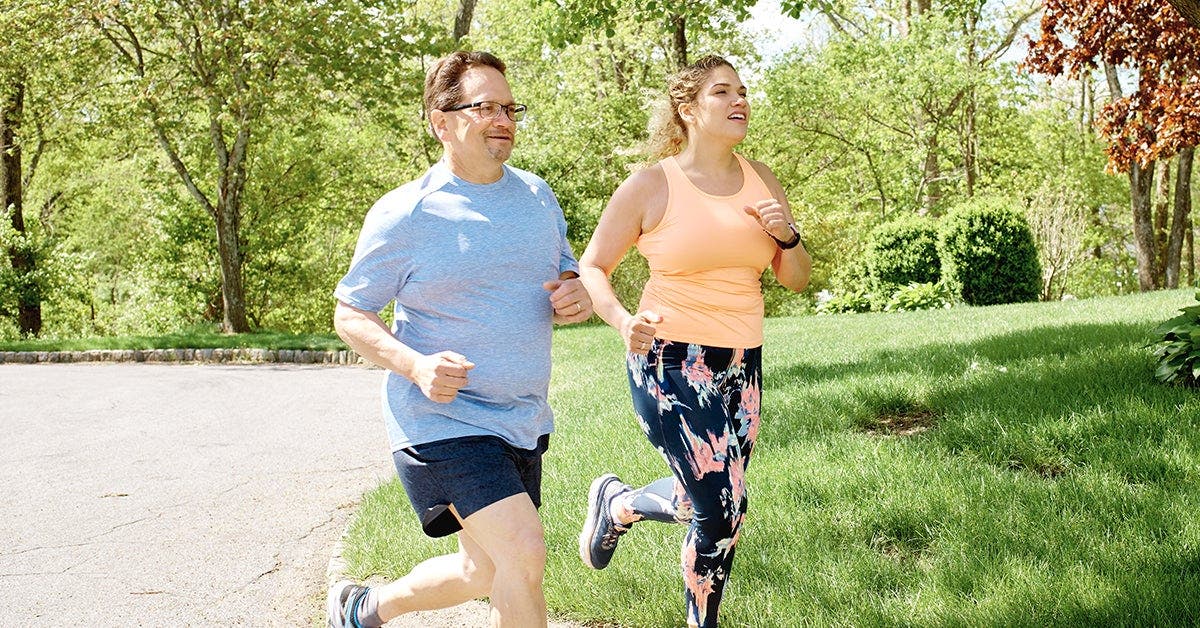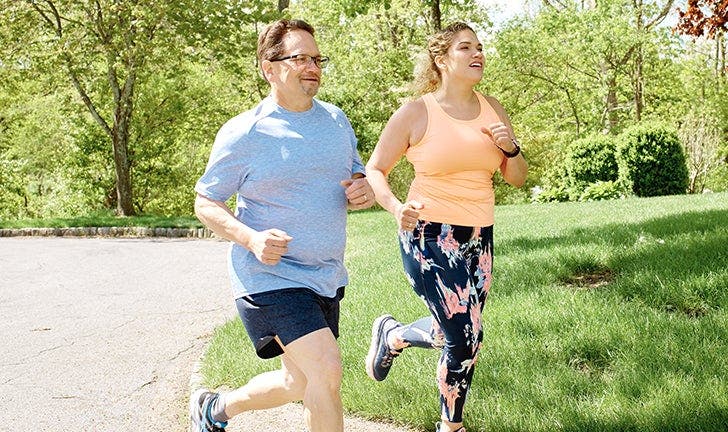Cardio Workouts, Defined


There are numerous benefits to cardio exercise, but it’s become more than just getting in 10,000 steps a day. Cardio—the word that describes moderate to vigorous activity that uses large muscle groups and spikes the heart rate to at least 65 percent of its max—isn’t the go-to for building muscle, but it does help individuals lose weight and get leaner, and has a positive impact on bone health.
“It increases the efficiency of the heart, and endurance of the muscles and heart,” explains Michele Olson, PhD, fellow at the American College of Sports Medicine (ACSM), and adjunct professor of sports science at Huntingdon College in Montgomery, Ala. “It also reduces the risk of heart disease because the heart becomes a strong muscle, beating less to pump out more blood.”
How often do you need to be doing cardio? Aim to be in an aerobic zone for at least 20 minutes, preferably 30 to 60 minutes, three to five times a week, explains Marius Maianu, ACSM certified exercise physiologist, SFG Level 1 instructor, and fitness consultant at Cooper Clinic in Dallas. “This is one of the best ways to improve the efficiency, stamina, and strength of the heart muscle,” he says.
So what activities are considered cardio? There are many that go beyond brisk walking. We spoke with our exercise physiologists to help explain the different types of cardio workouts, the benefits, and why you might want to try them.
Circuit Training
If running on a treadmill isn’t your thing, circuit training may be a good way to get in cardio, as it’s safe for beginners and advanced gym-goers alike. “It’s all about moving from one exercise to another,” explains Olson. “You can do just cardio moves like jumping rope, then box step-ups, followed by jumping jacks, or set up a weight- training circuit with exercises like jumping jacks, dumbbell squats, skipping rope, push-ups, step-ups, then back rows, so weights are infused with cardio stations.” You’ll get the cardio benefits, and if you include resistance-training, you’ll also get stronger and develop muscle while you’re burning calories.
High-Intensity Interval Training
Also known at HIIT, this type of interval exercise is all about getting the most out of a short period of time. HIIT is a technique where you give all-out effort through quick bursts of exercise, followed by short rest periods that may sometimes even be active recovery. “It’s more effective at reducing belly fat and has an afterburn effect, too, unlike some cardio, but you have to push yourself to about 90 percent of your max heart rate in order to truly be doing HIIT,” explains Olson. And this type of training is best suited for those who have already been doing cardio. It is not always safe for a sedentary person to start with this type of training as it’s more advanced, warns Maianu.
Kettlebell Training
While kettlebells are a resistance tool, because most exercises involve swinging the bells, there’s a nice cardio benefit to kettlebell training, too. “They’re designed to develop muscular endurance rather than pure strength and use the entire body, including the legs, core, back, shoulders, and hips,” says Olson. Don’t be fooled though—they’re not as simple to use as you might think and form is of utmost importance. If you’re new to kettlebells, it’s essential to first learn how to correctly use them before working out with them or you can end up really hurting yourself.
Non-Impact Activities
Biking, rowing, and swimming are good for all levels and have similar cardio benefits. “Rowing and swimming more actively engage the upper body and core, but all three have no impact so they’re beneficial for people with frail bones, such as individuals with osteoporosis or other orthopedic issues including back pain from a herniated disk,” explains Olson.
Sprints or Speed Work
Running fast for short periods of time—about 30 seconds or less—is an anaerobic type of exercise. And speed work is similar, but you may also be running backwards, or laterally side to side. “Sprints and speed work improve balance, power, strength, and running efficiency, utilizing fast twitch muscle fibres, which tend to be less functional as we age,” explains Maianu. “This type of training is more athletic and may not be suitable for a sedentary individual initially. One needs to have a good base of strength training and good overall muscle function to partake in speed type training.”
Steady State Cardio
It’s exactly as the name states—cardio that gets your heart rate up to an aerobic level, or 60 to 85 percent of your max heart rate, and keeps it there for 30 minutes or more. Think a long brisk walk on the treadmill or the elliptical. “Everyone who has medical clearance from his or her doctor that it is safe to exercise can do steady-state safely, even if you’ve never done cardio before,” explains Maianu.
Tabata
Discovered by a doctor and team of researchers in Japan, Tabata is all about intensity and precise timing. It’s similar to HIIT, but the exact length of work versus rest is specified with Tabata. It involves short bouts of 20 seconds on doing an exercise, followed by 10 seconds of rest. “This is more anaerobic exercise as it raises the heart rate between 85 and 100 percent of its max,” explains Maianu. “It also has an afterburn effect, improves glucose or sugar metabolism, and has the ability to improve your fitness level with less time exercising.” An afterburn effect describes your body burning calories to heal or recover from the activity. Again, because of its intensity, this type of training is best suited for those familiar with cardio and interval training, and only done three to four times a week with at least a day rest in-between training sessions
